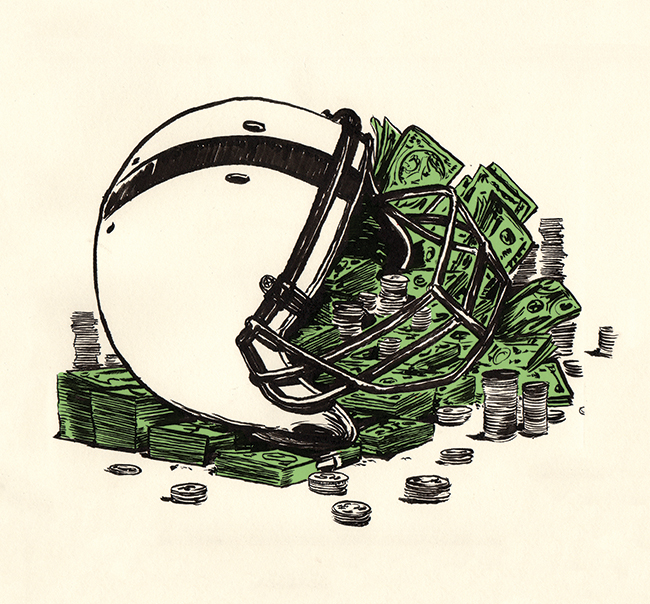ZEITGUIDE TO FOOTBALL’S FUTURE

At the time of the first NFL championship game in 1967, the winning quarterback (Bart Starr of the Packers) was paid $100,000 a season. A 30-second ad spot cost $37,500. The halftime show? College marching bands.
Here we are at Super Bowl 50, with more than 100 million viewers, $5-million TV ads and quarterbacks pulling down $10-$12 million just in product endorsements. Oh yeah, and Beyoncé and Coldplay at halftime.
Many sportswriters speculate that the upstart Carolina Panthers will overwhelm 39-year-old quarterback Peyton Manning and the Denver Broncos, or the game could be a low-scoring, defensive slugfest. So if things get dull, here are some topics to talk about at your Super Bowl party between trips to load up on buffalo wings.
ARE CONCUSSIONS AND CTE DIMINISHING THE POPULARITY OF FOOTBALL?
As more evidence about the game’s destructive impact on players comes to light, pro football seems headed toward an existential crisis. This week it was revealed that the late Raiders quarterback Ken Stabler had advanced chronic traumatic encephalopathy, or CTE, believed to be caused by repeated blows to the head. The NFL tallied 271 player concussions this season and several young players retired in the last off-season citing the risk of head injury. Even Super Bowl XL hero Antwaan Randle-El has said he regretted his choice to play football, citing memory and walking problems. On the other hand, when Mo Rocca asked legendary running back Tony Dorsett in his CBS Sunday Morning piece if he would do it all again he replied, “Absolutely.”
WHAT ELSE COULD BRANDS DO WITH THE MONEY THEY DROP ON A SINGLE SUPER BOWL AD?
Yes, $5 million seems like a lot for a single 30-second TV ad spot — but it does reach an audience of more than 100 million people. Here’s a sample of what advertisers could buy for that money instead, according to ADWEEK:
5 custom Twitter emojis
8-10 YouTube masthead ads
10.5 premium Instagram campaigns
12.5 days of sponsored snaps on Snapchat
2.1 million mobile app installs
15 million search ad clicks
250 million Facebook video views
WHY DO NETWORKS PAY SO MUCH TO BROADCAST FOOTBALL?
In our ZEITGUIDE 2016, we posited that streaming video services could eventually enable leagues to become their own media outlets selling games or seasons directly to the sports fan. For now, however, selling broadcast rights to networks is proving far more lucrative. For example, CBS and NBC recently agreed to pay $450 million to broadcast Thursday night football games next season, even though analysts suggest the broadcasts will generate just $215 million in revenue. How long can that go on?
WHY DOES EVERYONE WANT TO BET ON FOOTBALL?
Even as daily fantasy sports sites like DraftKings and FanDuel have come under fire as a form of illegal gambling, it’s clear that nothing will stop people from wagering on sports. An estimated $4.2 billion will be bet on Sunday’s game. In Las Vegas, where sports betting is legal, one casino has a list of more than 400 “prop bets” such as, “Will either team score three times in a row?” Or, “Will Cam Newton throw a touchdown pass in the first quarter?” (Bleacher Report suggests betting on the halftime entertainment, too.) Apparently bettors are just trying to make the game more interesting, because nearly no one is winning any cash. Sports gambling has one of the lowest winning percentagesaccording to the Nevada Gaming Board: just 5.8% last year compared with 6.4% for slot machines, 12% for blackjack and 18% for roulette.
IS FOOTBALL FARE MOVING BEYOND CHICKEN WINGS?
Super Bowl Sunday ranks just below Thanksgiving as the nation’s second-biggest day for outright gluttony. But if Levi’s Stadium is any reflection, we’re moving beyond hotdogs and Bud Light. Food concessions at the game include locally sourced food, scores of California wines and the largest selection of vegan options of any stadium.
